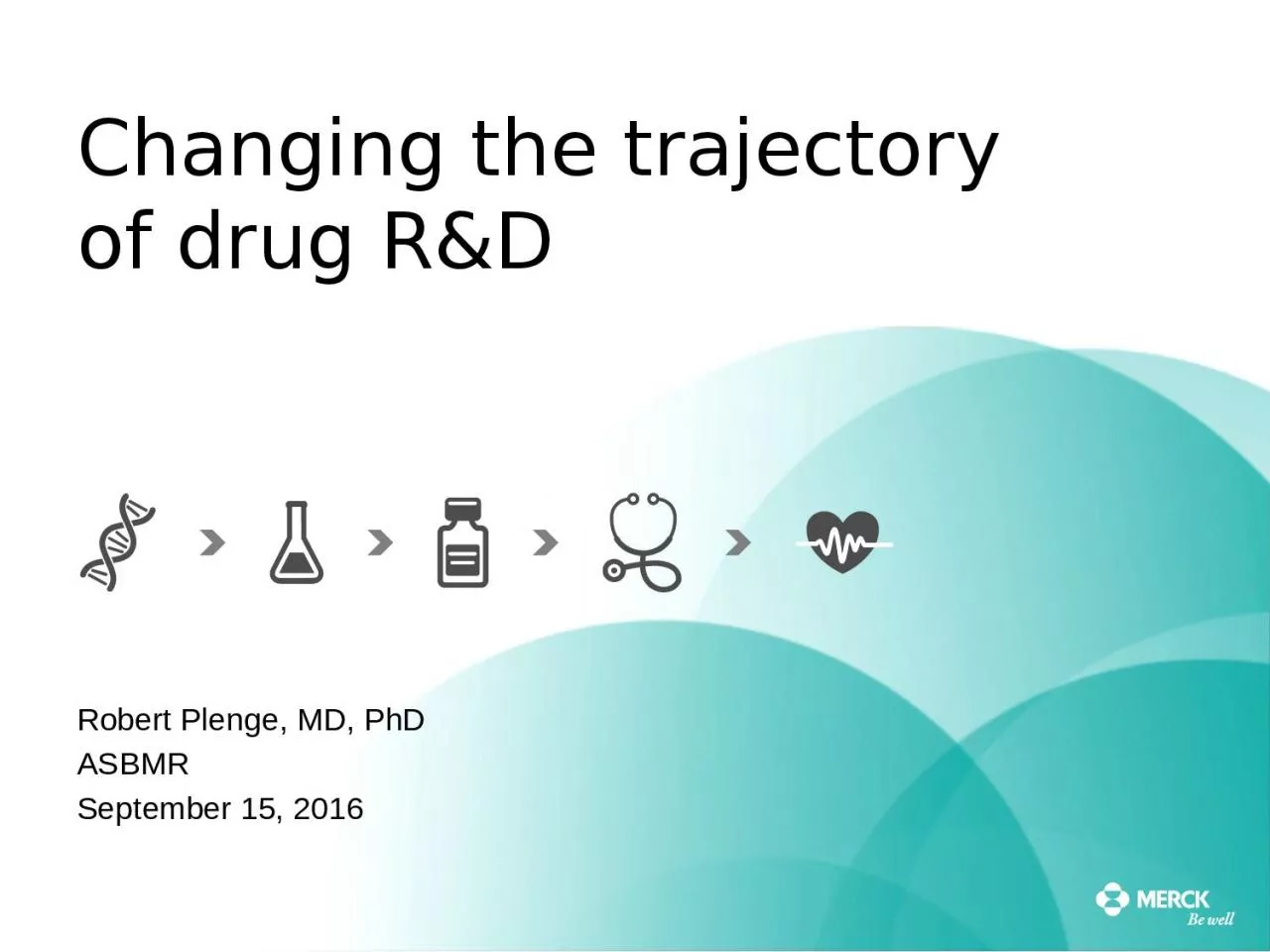

Robert Plenge MD PhD ASBMR September 15 2016 Our two fundamental challenges Cost to develop an asset has increased by 13 rd since 2010 Average peak sales per asset has halved since 2010 ID: 1012639
Download Presentation The PPT/PDF document "Changing the trajectory of drug R&D" is the property of its rightful owner. Permission is granted to download and print the materials on this web site for personal, non-commercial use only, and to display it on your personal computer provided you do not modify the materials and that you retain all copyright notices contained in the materials. By downloading content from our website, you accept the terms of this agreement.
1. Changing the trajectory of drug R&DRobert Plenge, MD, PhDASBMRSeptember 15, 2016
2. Our two fundamental challengesCost to develop an asset has increased by 1/3rd since 2010Average peak sales per asset has halved since 2010
3. Where things go wrong & what that costsAbout 1 out of 10 programs make it to Phase IIIPaul et al NRDD 2010But critical phase is choice of target and early development$$$
4. We relied on preclinical models to pick targets and estimate efficacy in heterogeneous human populationsDiscovery (new targets)Optimization(pre-clinical)Early DevelopmentIt was…
5. Today, humans are the model organism of choice for new targets and precision medicineDiscovery (new targets)Optimization(pre-clinical)Early Development
6. Science Translational Medicine, July 27, 2016
7. First, an example from cardiovascular disease
8. There are examples of human genetics leading to new drug targets (PCSK9)…and design studies to find drugs that fix the underlying molecular defects – for example, blocking PCSK9 lowers LDL (or “bad”) cholesterol in the blood.LysosomeLDLRPCSK9LDL-CmAbLDLRRecyclingMany genes influence cholesterol levels and risk of heart diseaseAtheroscleroticPlaqueBlood FlowPCSK9 mutations associated with high and low LDL cholesterol levels (and heart disease risk)
9. Now, examples from osteoporosis and fracture risk
10. >100 common variants associated with osteoporosis Additional genes mutated in rare forms of bone mass loss / accrualExperimental studies determine function, including gain- vs loss-of-function of risk alleleWhile many genes implicated, only a few have led to novel therapies…and those occur at the intersection of multiple alleles & functionA quick primer on genetics of osteoporosis and related traitsDavid Karasik et al NRR 2016
11. FUNCTIONALSTUDIESMONOGENICTRAITSGENOME-WIDE ASSOCIATION STUDIES (GWAS)Denosumabanti-RANKLapprovedRomosozumabanti-sclerostinphase IIITeriparatiderecombinant PTHapproved
12. Denosumabanti-RANKLapprovedRomosozumabanti-sclerostinphase IIITeriparatiderecombinant PTHapprovedosteoblastEstrada et al NG 2012
13. Gene functionHuman PhenotypeHighLowGOFLOFPick a human phenotype for drug efficacy
14. Gene functionHuman PhenotypeHighLowGOFLOFPick a human phenotype for drug efficacyNelson et al NG 2015
15. Gene functionHuman PhenotypeHighLowGOFLOFXXXXXXXPick a human phenotype for drug efficacyIdentify a series of alleles with range of effect sizes in humans (but of unknown function)
16. Gene functionHuman PhenotypeHighLowGOFLOFXXXXXXXPick a human phenotype for drug efficacyAssess biological function of alleles to estimate “efficacy” response curveEfficacy
17. Gene functionHuman PhenotypeHighLowGOFLOFAssess biological function of alleles to estimate “efficacy” response curveEfficacyXXXXXXXToxicityAssess pleiotropy as proxy for ADEsPick a human phenotype for drug efficacyNew target fordrug screen!This provides evidence for the therapeutic window at the time of target ID & validation.
18. Gene functionOsteoporosisHigh bone densityLow bone densityGOFLOFEfficacyXXXXXXXToxicityAssess pleiotropy as proxy for ADEsPick a human phenotype for drug efficacyRANK-RANKL and denosumabThis provides evidence for the therapeutic window at the time of target ID & validation. Rare RANK variants & Paget’s disease (no known GoF mutations in RANKL)Rare variants & osteopetrosisCommon variants & BMD, fracture risk
19. Gene functionOsteoporosisHigh bone densityLow bone densityGOFLOFEfficacyXXXXXXXToxicityNo “obvious” pleiotropic effects that could be ADEsPick a human phenotype for drug efficacyRANK-RANKL and denosumabThis provides evidence for the therapeutic window at the time of target ID & validation. Rare RANK variants & Paget’s disease (no known GoF mutations in RANKL)Rare variants & osteopetrosisCommon variants & BMD fracture risk
20. Therapeutic modulationmAb mimics human mutation Biomarkers of bone turnoverUrinary& serum NTX Serum bone-specific alkaline phosphataseSmall (n=49) clinical PoB experimentPrimary outcome change in bone turnover markersLarge (n=7,808) RCT for fracture risk reductionReduced risk of new vertebral fracture by 68% vs. placebo (P < 0.001)Clinical development of denosumabGoessl et al Ann. N.Y. Acad. Sci. 2012
21. But (and there is always a but…)
22. Not all successful drugs will have genetic supportOther approaches to causal human biology & drug discoveryEven those targets with genetic support may fail in clinical developmentCathepsin K (CTSK) mutations cause pycnodysostosisOdanacatib failed in Phase III due to safety Limitations of the approach
23. Introducing novel therapies is an important component of our future health care system……but we need to do more to deliver affordable medicines that matter
24. Questions?@rplenge